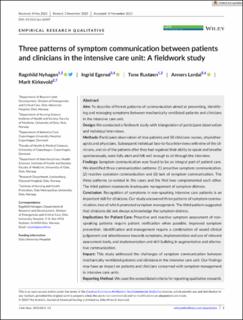| dc.contributor.author | Nyhagen, Ragnhild | |
| dc.contributor.author | Egerod, Ingrid | |
| dc.contributor.author | Rustøen, Tone | |
| dc.contributor.author | Lerdal, Anners | |
| dc.contributor.author | Kirkevold, Marit | |
| dc.date.accessioned | 2024-01-18T07:41:17Z | |
| dc.date.available | 2024-01-18T07:41:17Z | |
| dc.date.created | 2023-12-19T14:25:12Z | |
| dc.date.issued | 2023 | |
| dc.identifier.citation | Journal of Advanced Nursing. 2023, . | en_US |
| dc.identifier.issn | 0309-2402 | |
| dc.identifier.uri | https://hdl.handle.net/11250/3112325 | |
| dc.description.abstract | Aim: To describe different patterns of communication aimed at preventing, identify-
ing and managing symptoms between mechanically ventilated patients and clinicians
in the intensive care unit.
Design: We conducted a fieldwork study with triangulation of participant observation
and individual interviews.
Methods: Participant observation of nine patients and 50 clinicians: nurses, physiother-
apists and physicians. Subsequent individual face-to-face interviews with nine of the cli-
nicians, and six of the patients after they had regained their ability to speak and breathe
spontaneously, were fully alert and felt well enough to sit through the interview.
Findings: Symptom communication was found to be an integral part of patient care.
We identified three communication patterns: (1) proactive symptom communication,
(2) reactive symptom communication and (3) lack of symptom communication. The
three patterns co-existed in the cases and the first two complemented each other.
The third pattern represents inadequate management of symptom distress.
Conclusion: Recognition of symptoms in non-speaking intensive care patients is an
important skill for clinicians. Our study uncovered three patterns of symptom commu-
nication, two of which promoted symptom management. The third pattern suggested
that clinicians did not always acknowledge the symptom distress.
Implications for Patient Care: Proactive and reactive symptom assessment of non-
speaking patients require patient verification when possible. Improved symptom
prevention, identification and management require a combination of sound clinical
judgement and attentiveness towards symptoms, implementation and use of relevant
assessment tools, and implementation and skill building in augmentative and alterna -
tive communication.
Impact: This study addressed the challenges of symptom communication between
mechanically ventilated patients and clinicians in the intensive care unit. Our findings
may have an impact on patients and clinicians concerned with symptom management
in intensive care units.
Reporting Method: We used the consolidated criteria for reporting qualitative research. | en_US |
| dc.language.iso | eng | en_US |
| dc.rights | Attribution-NonCommercial-NoDerivatives 4.0 Internasjonal | * |
| dc.rights.uri | http://creativecommons.org/licenses/by-nc-nd/4.0/deed.no | * |
| dc.title | Three patterns of symptom communication between patients and clinicians in the intensive care unit: A fieldwork study | en_US |
| dc.type | Peer reviewed | en_US |
| dc.type | Journal article | en_US |
| dc.description.version | publishedVersion | en_US |
| cristin.ispublished | true | |
| cristin.fulltext | original | |
| cristin.qualitycode | 2 | |
| dc.identifier.doi | 10.1111/jan.16007 | |
| dc.identifier.cristin | 2215690 | |
| dc.source.journal | Journal of Advanced Nursing | en_US |
| dc.source.pagenumber | 0 | en_US |

